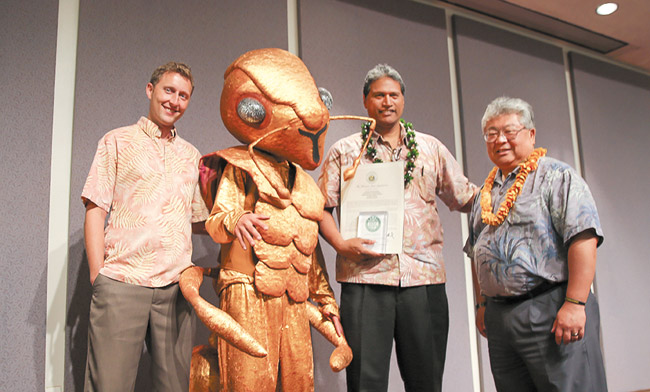Hawaiian Airlines Works To Keeps Pests Out Of Our State

Hawaiian Airlines cargo manager–Honolulu Station George Ka‘anana accepted the 2014 Business Leader Award from Hawaii Invasive Species Council on behalf of his employer, Hawaiian Airlines. The company was recognized as a leader in the area of prevention of invasive pest species movement. Pictured with a life-size fire ant are (from left) Joshua Atwood of Hawaii Invasive Species Council, Ka‘anana and state Rep. Richard Onishi. Photo from Hawaiian Airlines.
For most Oahu residents, the shrill chirps of coqui frogs and the bite of a little fire ant are abstract dangers, but for those inspectors on the front lines of the battle against the spread of invasive species, the struggle begins and ends anew every day.
Though they may seem like mere pests, invasive species in Hawaii can be severely harmful to the state’s unique biodiversity.
For example, innocuous gorilla ogo smothers coral reefs and marine life in Waikiki and Kaneohe Bay. Left unchecked, that little seaweed, and everything from false kava to nettle caterpillars, could have irreversible impacts on Hawaii’s environment.
That’s why Hawaii Invasive Species Council (HISC) has given Hawaiian Airlines its 2014 Business Leader Award for its efforts to keep these kinds of pests from spreading through the state.
“Our biggest effort (at cargo) truly is to accommodate our customers with their freight from point A here in Honolulu to wherever Hawaiian Airlines flies and takes their cargo,”
said George Ka‘anana, a Pearl City resident and cargo manager-Honolulu Station for Hawaiian Airlines, who helps coordinate the airline’s efforts to fight invasive species at Honolulu International Airport.
“The thing with invasive species is they can pretty much latch onto anything.”
All those boxes and bags, after all, come with the risk of bringing in a few unwanted stowaways.
As a result, Hawaiian Airlines collaborates constantly with the state Department of Agriculture, with daily freight inspections and updates on new priorities. Ka‘anana said that during the little fire ant breakout in late 2014, state officials briefed the airlines about what to look for, and both groups increased their scrutiny of interisland cargo.
For the public, awareness is the key.
“People are basically aware of issues only if they see it in the newspaper or on TV,” Ka‘anana said, noting that, even so, most people don’t realize the full extent of the harm caused by invasive species or how easy it is for them to spread from island to island. “Travelers can help to reduce the issue just by being more conscious of what they transport into the Islands.”
To this end, Hawaiian Airlines runs in-flight videos on its Mainland and international flights to Hawaii that explain to travelers why filling out agricultural declaration forms is important and why cargo inspections are necessary to stop the spread of invasive species. Ka‘anana also thinks that more can be done to promote awareness on Hawaiian’s interisland flights.
“Be sure to fill out the state agricultural declaration forms because these really do help us in minimizing the issue,” Ka‘anana urged. “But at the same time, as residents living here in Hawaii, we all should help raise awareness of this issue with each other, in order to keep our beautiful home protected from invasive species.”
For more information on invasive species threatening Hawaii, visit HISC’s website at dlnr.hawaii.gov/hisc.





